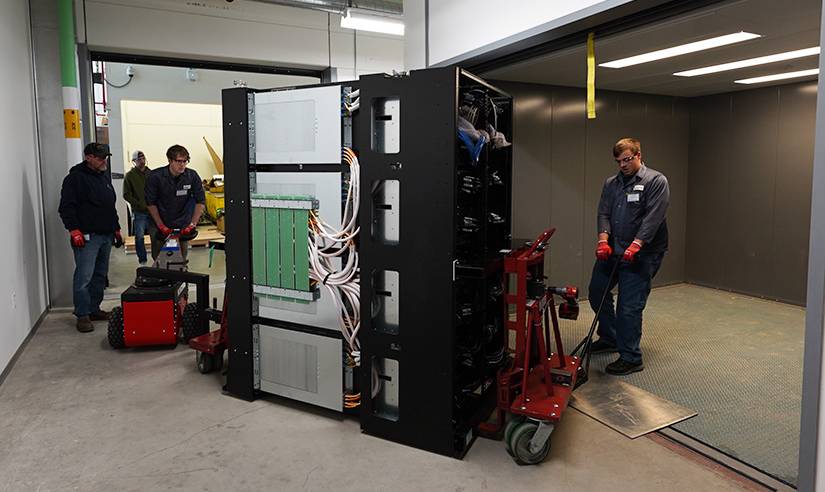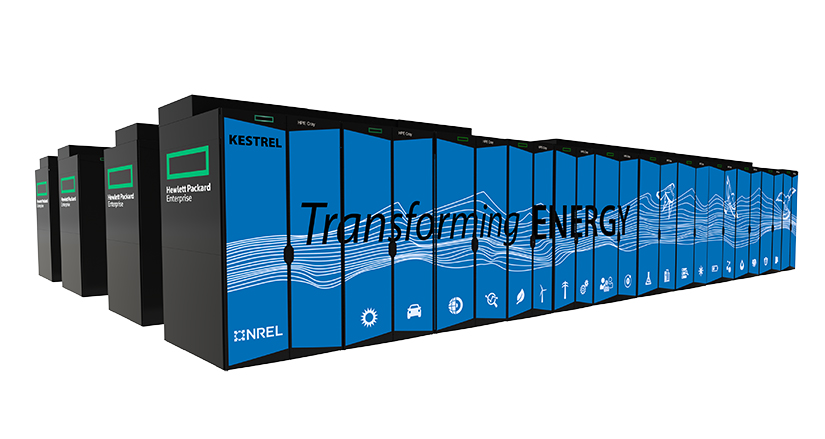Kestrel Supercomputer Arrives at NREL

One of several cabinets of CPU nodes was recently delivered to NREL for installation as part of the laboratory’s new HPC system, Kestrel. Photo by Joe DelNero, NREL
The first delivery of the National Renewable Energy Laboratory’s (NREL’s) latest high-performance computing (HPC) system, Kestrel, arrived Monday, documented in a time-lapse video on the "Countdown to Kestrel Blog." The operations teams are working to install the CPU-based compute nodes and the underlying network and storage systems so Kestrel’s first phase can undergo testing and be ready for research computing this summer.
The second phase of Kestrel, comprising the graphics processing unit (GPU)—or “accelerator”—nodes is expected to arrive in the fall. Kestrel’s heterogeneous architecture, including CPU-only and GPU-accelerated nodes, is designed to better enable emerging workflows such as artificial intelligence and machine learning, providing the U.S. Department of Energy (DOE) and industry partners with the ability to tackle energy challenges and move into a renewable and sustainable future.
As the dedicated HPC system for the DOE Office of Energy Efficiency and Renewable Energy (EERE), Kestrel will play a critical role in computing including advancing research in computational materials, continuum mechanics, and large-scale simulation and planning for future energy systems. For example, Kestrel’s accelerated, more powerful computing will allow NREL to develop simulations that project optimal charging station infrastructure for electric vehicles across the country, or to model the behavior of atoms and electrons that aid improvements in the manufacturing of solar cells, which convert energy from the sun into electricity.
“Supercomputers like Kestrel are critical to the energy transition,” said EERE Acting Assistant Secretary Alejandro Moreno. “Kestrel will enable the EERE research community to apply cutting-edge simulations and harness artificial intelligence to advance affordable, reliable clean-energy technologies at the scale we need to reach our country’s climate and energy goals.”

Kestrel is being built by Hewlett Packard Enterprise (HPE) and designed using the HPE Cray EX system with full compatibility with the warm-water waste-heat-recovery system currently used in NREL’s Energy Systems Integration Facility (ESIF) data center.
“From driving discoveries in microscopic battery chemistry to simulating and enabling global energy infrastructure transition, Kestrel will accelerate our research capabilities to meet administration goals for clean and renewable energy,” EERE Grid Integration Director and Computing Program Manager Kevin Lynn said.
When fully installed, Kestrel will accelerate energy efficiency and renewable energy research at a pace and scale more than five times greater than NREL’s current supercomputer, Eagle—learn how the two systems stack up. Kestrel’s highly anticipated arrival augments NREL’s ability to deliver HPC solutions today to achieve energy promises for tomorrow.
Last Updated May 28, 2025
